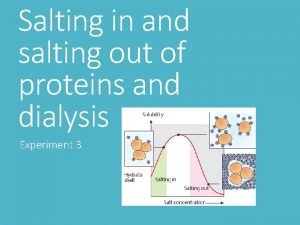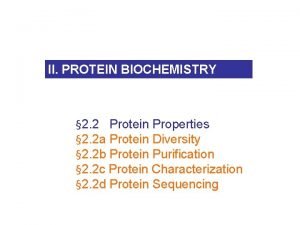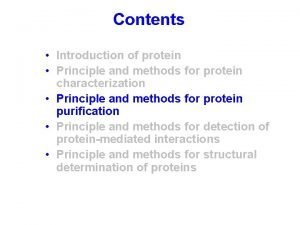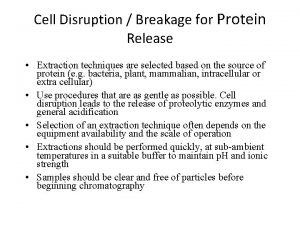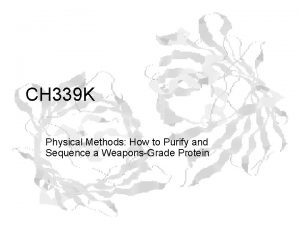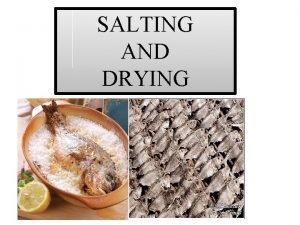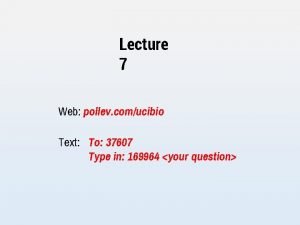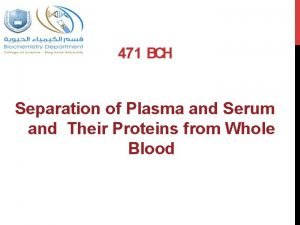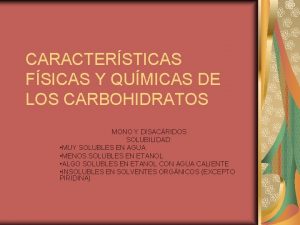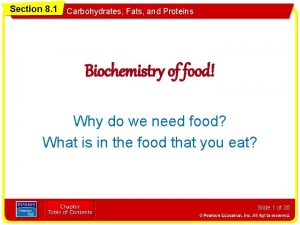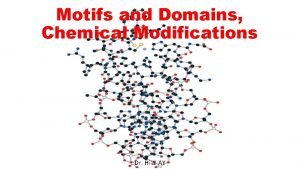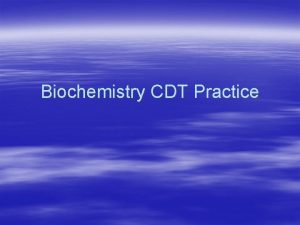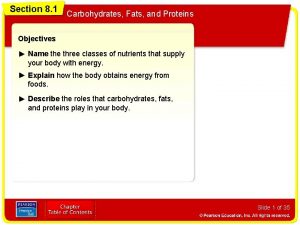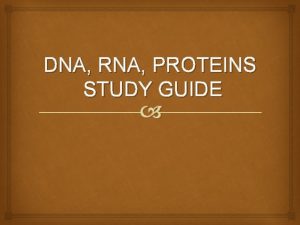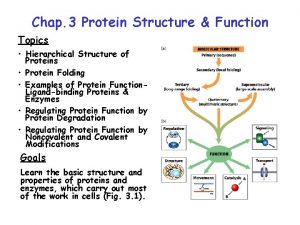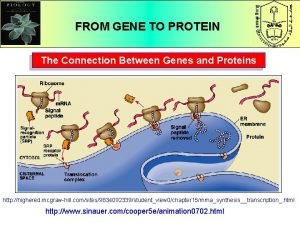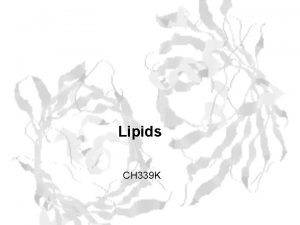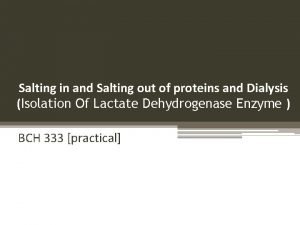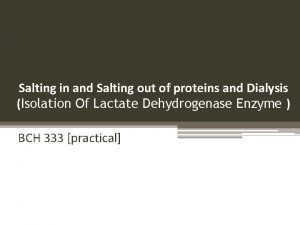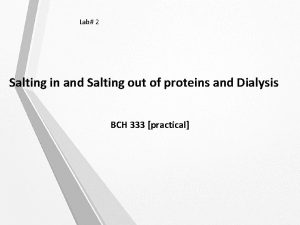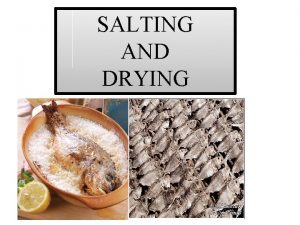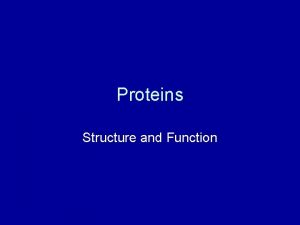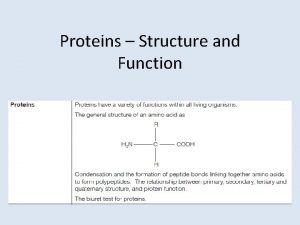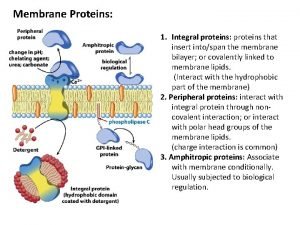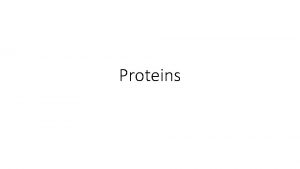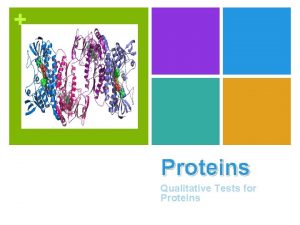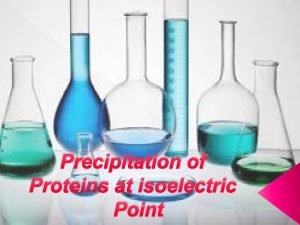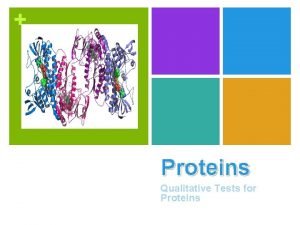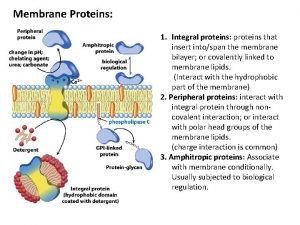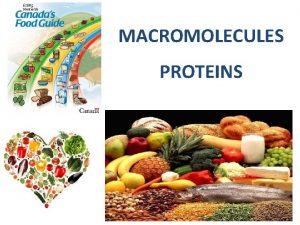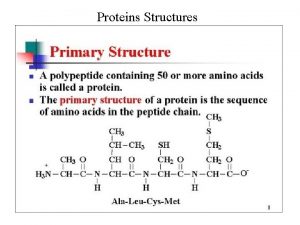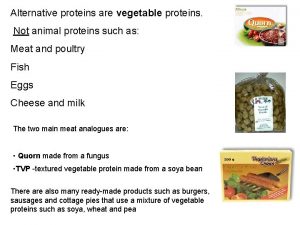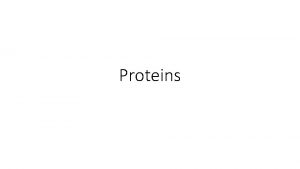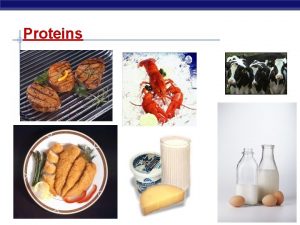Salting in and salting out of proteins and




















- Slides: 20

Salting in and salting out of proteins and dialysis Experiment 3

objectives To learn one of the technique for protein isolation on the basis of their solubility. This experiment consists of two parts Part I: salting in, salting out of proteins and dialysis of proteins. Part II: Determination of protein content by biuret assay In this lab you will try to isolate Lactate Dehydrogenase from a skeletal muscle of chicken.

Protein Isolation and Purification Protein purification is a series of processes intended to isolate one or a few proteins from a complex mixture, usually cells, tissues or whole organisms. Whole Tissue Protein to be studied a series of processes to remove other unwanted proteins and components (Protein can not be isolated by only one step only)

Isolation of proteins 1. First Step is tissue homogenization 2. Isolation techniques utilize different properties of proteins: • Solubility (salt, p. H, temperature) • Charge • Size • Binding properties (Ligands)

Protein precipitation by salt • Proteins show a variation in solubility depending on the ionic environment of their solution. (salts) • When low concentrations of salt is added to a protein solution the solubility increases. • Beyond a certain point after continuing addition of salt, the protein solubility start to decrease leading to exclusion of protein out of the solution in the form of precipitate. • The point where the precipitation start is different between different protein


Salting In Low concentrations of salt the solubility increases. This could be explained by the following: Salt molecules stabilize protein molecules by : Decreasing the electrostatic energy between the protein molecules which increase the solubility of proteins. H 2 O salt H 2 O + + - H 2 O +

Salting out High concentration of salts the solubility decreases, and protein precipitates. This could be explained by the following: 1. because the excess ions (not bound to the protein) compete with proteins for the solvent. 2. The decrease in solvation allows the proteins to aggregate and precipitate. The protein molecules tend to associate with each other because protein-protein interactions become energetically more favorable than protein-solvent interaction.

Salting out - H 2 O + + - H 2 O + - + H 2 O More salt + H 2 O + + - + H 2 O + + + - H 2 O -

Salting out • Unwanted proteins can be removed from a protein solution mixture by salting out • After removing the precipitate by filtration or centrifugation, the desired protein can be precipitated by altering the salt concentration to the level at which the desired protein becomes insoluble.

Important points The most effective region of salting out is at the isoelectric point of the protein. . Why? ? Different protein molecules precipitate at different concentrations of salt solution because different proteins have different compositions of amino acids The salt commonly used is ammonium sulfate because: 1. Its large solubility in water. 2. Its relative freedom from temperature effects. 3. It has no harmful effects on most of the proteins. -Increase solute – solvent interaction increase the solubility. -Increase solute – solute interaction decrease the solubility. -Increase ionic strength increased salt concentration.

The amount of salt needed to isolate a specific protein is determined from the salt's fractionation table. Note: that the table indicate the grams of the salts to be added to one liter of solution.

Salting out and protein isolation and purification • Salting out with ammonium sulfate is a technique that is used as an early step in purification scheme. • Significant purification is not achieved, but broad ammonium sulfate cut at least a volume of unwanted proteins. • The amount of salt needed to isolate a specific protein is determined from the salt's fractionation table.

Dialysis • Removal of salt molecules from the isolated protein solution through a semi permeable dialysis bag • The salt molecules move from the more concentrated solution (from inside the dialysis bag) to the less concentrated solution ( e. g. distilled water).

Biuret assay of protein The biuret reagent is: alkaline copper sulphate . This colored complex can be measured quantitatively by a spectrophotometer in the visible region. The color obtained is directly proportional to the number of peptide bonds present in the protein. The assay is called Biuret because the reaction is positive with the biuret reagent. In this experiment the amount of isolated protein from the skeletal muscle is determined by the biuret assay and from the standard curve of bovine serum albumin (BSA).

Practical part Partially of LDH Salting Out Dialysis Determination of protein Note: Lactic Acid Dehydrogenase [LDH], in an important enzyme in the anaerobic metabolism of glucose for the generation of ATP. Pyruvate + NADH ---------> Lactic acid + NAD+ LDH

A- Isolation of LDH: Skeletal muscle Buffer with suitable p. H Crude extract ? ? Homogenate

Centrifuge at 2000 rpm for 10 min. at 4˚C. B Supernatant (LDH + Other proteins ) Crude extract Pellet (Extraneous proteins) The volume of the supernatant saturate the solution 40% using ammonium sulfate in grams. Centrifugation Supernatant (40% sat. ) B (LDH + Other proteins ) The volume of the supernatant Pellet (unwanted proteins)

Centrifugation saturate the solution 60% using ammonium sulfate in grams. Supernatant (60% sat. ) (unwanted proteins ) B B-Dialysis C-Protein assay: Determination of protein by Biuret Method Pellet (LDH + other proteins)

References • Biochemical Methods
 Salting in salting out
Salting in salting out Purification yield calculation
Purification yield calculation Salting in
Salting in Salting in salting out
Salting in salting out Salting in
Salting in Dry salting of fish
Dry salting of fish One direction figurative language
One direction figurative language Protein solubility
Protein solubility Heat coagulation principle
Heat coagulation principle Salting out fundamento
Salting out fundamento Put out the light othello
Put out the light othello Section 8-1 carbohydrates fats and proteins answer key
Section 8-1 carbohydrates fats and proteins answer key Motifs and domains of proteins
Motifs and domains of proteins Organic compounds such as proteins and starches are too
Organic compounds such as proteins and starches are too Lbv foods examples
Lbv foods examples Section 8-1 summary carbohydrates fats and proteins
Section 8-1 summary carbohydrates fats and proteins What are the functions of proteins
What are the functions of proteins Dna rna and proteins study guide answers
Dna rna and proteins study guide answers Protein structure
Protein structure What is the connection between genes and proteins
What is the connection between genes and proteins Integral and peripheral proteins
Integral and peripheral proteins
